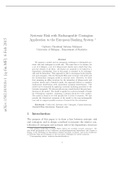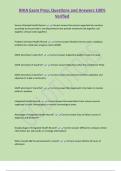Systemic Risk with Exchangeable Contagion:
Application to the European Banking System ∗
arXiv:1502.01918v1 [q-fin.MF] 6 Feb 2015
Umberto Cherubini†, Sabrina Mulinacci
University of Bologna - Department of Statistics
Abstract
We propose a model and an estimation technique to distinguish sys-
temic risk and contagion in credit risk. The main idea is to assume, for
a set of d obligors, a set of d idiosyncratic shocks and a shock that trig-
gers the default of all them. All shocks are assumed to be linked by a
dependence relationship, that in this paper is assumed to be exchange-
able and Archimedean. This approach is able to encompass both systemic
risk and contagion, with the Marshall-Olkin pure systemic risk model and
the Archimedean contagion model as extreme cases. Moreover, we show
that assuming an affine structure for the intensities of idiosyncratic and
systemic shocks and a Gumbel copula, the approach delivers a complete
multivariate distribution with exponential marginal distributions. The
model can be estimated by applying a moment matching procedure to the
bivariate marginals. We also provide an easy visual check of the good spec-
ification of the model. The model is applied to a selected sample of banks
for 8 European countries, assuming a common shock for every country.
The model is found to be well specified for 4 of the 8 countries. We also
provide the theoretical extension of the model to the non-exchangeable
case and we suggest possible avenues of research for the estimation.
Keywords: Credit risk, Systemic risk, Contagion, Copula functions,
Marshall-Olkin distribution, Financial crisis
1 Introduction
The purpose of this paper is to draw a line between systemic risk
and contagion, and to design a method to measure the relative con-
tribution of contagion and systemic risk to the dependence structure
∗ Theauthors would like to thank Robin Treber for excellent research assistance. We
also thank participants in the Conference on High-Dimensional Dependence and Copula in
Bejing, in the Workshop on Dependence Models and Risk, in Bozen, and in the Conference
on Systemic Risk and Contagion at the University of Bologna for useful comments.
† Corresponding author: umberto.cherubini@unibo.it.
1
,of a set of credit exposures. The statistical problem of disentangling
systemic risk and contagion is of utmost relevance for economic pol-
icy. In several problems, such as pollution regulation or banking,
recognizing systemic risk, as an event independent of the agents, or
contagion, that is a system wide event triggered by one of them, is
a major discriminant factor to decide whether the effects should be
charged to the community at large or to the individual agents.
The problem is involved for two reasons. The first, already ad-
dressed in many studies on the subject, is that the systemic risk
factor is not observed and for credit risk applications we are only
able to extract the marginal survival probabilities from the market.
The second reason, that is the subject of this paper, is whether such
dependence is explained by the presence of a systemic risk factor
only, or of some infectious elements in the system.
To make the problem clear, assume that we are allowed to observe
the systemic risk factor, and we are able to appraise the probability
of a systemic crisis. In this situation, the question would natu-
rally arise whether the systemic shock is independent of the other
events triggering the default of each component of the set. Answer-
ing this question on practical grounds would be obviously easy in
this setting, and the dependence between idiosyncratic and systemic
triggers of default could be estimated in the usual way, e.g. using
copulas.
Notice, however, that even if dependence with the systemic risk fac-
tor were observed, a problem of interpretation of these results on
theoretical grounds would arise concerning how it would affect the
observed dependence structure of the components in the system.
In fact, the presence of a systemic factor is sufficient to induce de-
pendence among the components of the system and between each
component and the systemic event. In other words, this depen-
dence shows up even if the systemic shock is independent of the id-
iosyncratic ones. Intuitively, if the idiosyncratic default drivers were
linked to the systemic risk trigger by a dependence relationship, the
degree of dependence in the system would be even stronger.
In this paper we propose a model to represent these two sources
of dependence in a tractable way. The idea of our model is very
simple. Given a cluster of d obligors, we assume that the system
is subject to a set of d + 1 shocks, one of which is common to all
the components and leads to simultaneous default of all the oblig-
2
,ors in the cluster, while the others are responsible for the default
of each component. Assume further that the times of these shocks
are linked by a copula function of dimension d + 1. It is immediate
to see that this model encompasses the two extreme cases of pure
systemic risk and pure contagion. Namely, in the case of a product
copula for the d + 1 occurrence times of the shocks, we obtain a
model with bivariate Marshall-Olkin marginal distributions, repre-
senting the pure systemic risk model. The opposite case arises when
the systemic shock has zero probability, so that we have a standard
survival copula model corresponding to pure contagion. Allowing
for positive probability of a systemic crisis and for dependence be-
tween this risk and the idiosyncratic credit drivers would then allow
to design models that represent both systemic risk and contagion.
In these models, the task of disentangling the two is a relevant ques-
tion.
In its simplest version, our paper assumes the standard restriction
of the choice of exchangeable copulas for the credit risk drivers.
This means that each idiosyncratic factor is assumed to be linked
by the same dependence structure to the systemic risk factor and to
the other idiosyncratic ones. We also show that further restrictions
change the copula model in a multivariate distribution model with
exponential margins. If the model may seem restrictive, on practi-
cal grounds we provide a methodology to verify if the assumption
is borne out by the data. Moreover, on theoretical grounds, we will
also provide the theoretical development for the non-exchangeable
version of model.
The plan of the paper is as follows. After reviewing the relevant lit-
erature, in Section 2 we motivate and describe in full generality our
credit risk model for a basket of issuers, we discuss its main prop-
erties and the restrictions that change the copula model in a mul-
tivariate distribution with exponential marginals. In Section 3 we
discuss the theoretical features of the extension to non-exchangeable
dependence of the credit risk drivers. Finally, in Section 4 we illus-
trate our application to the banking system of a set of countries of
the Euro area. In Section 5 we report conclusions and a discussion
of the main issues left for future research.
3
, 1.1 Related literature
Our paper is related to a large literature on the measurement of sys-
temic risk and contagion, even though to the best of our knowledge
it is the first attempt to disentangle the two. Leaving aside any hope
of being exhaustive, we may provide a taxonomy of the main con-
tributions according to the structure of models and the data used.
As for the methodology involved, a first class of models are based
on the application of Granger causality, and related concepts, to the
prices of financial assets (Billio et al.,2012). A second set of models
is based on the network representation of the relationships among
financial institutions (Diebold and Yilmaz, 2011). A third approach
is based on the theory of risk measures applied to systemic risk and
contagion. Models in this class are based on the measurement of
expected losses conditional on an extreme scenario of some systemic
risk factor. The technique is the same as expected shortfall, with the
difference of conditioning with respect to a systemic variable. These
measures are called Marginal Expected Shortfall, MES (Acharya et
al., 2010), and CoVaR (Adrian and Brunnermeier, 2011). Cherubini
and Mulinacci (2014) give conditions to ensure that coherence re-
quirements be met, and propose examples of measures in this class
based on copula functions.
Coming to the kind of data that are used in the empirical analysis,
we may distinguish between applications that rely on the analysis of
market prices, and those that use flows and balance sheet data. The
first choice use equity stock prices (Billio at al., 2012) or volatili-
ties (Diebold and Yilmaz, 2011), credit spreads of bonds and credit
derivatives (Baglioni and Cherubini, 2013). With this choice, the fo-
cus is on measurement of the effects of systemic risk and contagion,
in terms of future cash flows and the default probability that are
implied in market quotes. The second choice exploits flows among
the financial intermediaries and the focus is more on the means that
explain propagation of the shocks through the financial intermedia-
tion system. Here the analysis is focussed on flows in the interbank
market (Bonaldi, Hortacsy and Kastl, 2013) or on several layers
representing other markets (Bargigli et al., 2013), or else on balance
sheet indexes such as leverage (Brownlees and Engle, 2010). All
these proxies are used as measures of the strength of contagion in
the system.
Our paper uses the default probability extracted from CDS and their
4





